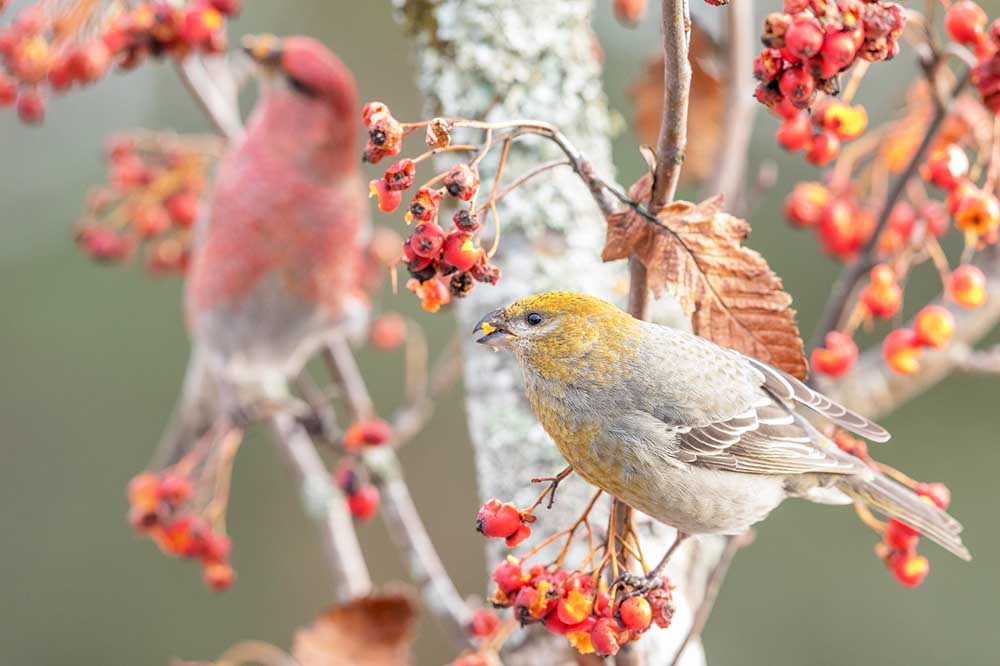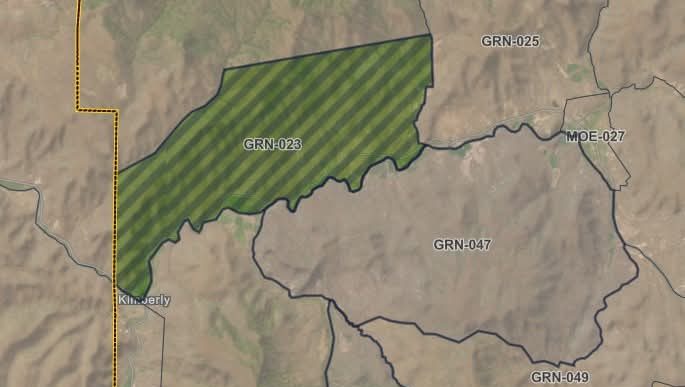Local birders spot rare visitor in 2023 John Day Christmas Bird Count
Published 1:08 pm Thursday, December 28, 2023

- A pine grosbeak was sighted for the first time during the 2023 John Day Christmas Bird Count. This undated image shows a pair of the birds, with a female in the foreground and a male in the background.
JOHN DAY — An unexpected visitor showed up in John Day for the holidays this year: a pine grosbeak.
Trending
The bird, usually found in more northerly climes, made its first appearance in the annual John Day Christmas Bird Count.
“I believe they’re endemic to the Wallowa Mountains, but normally they’re more of a Canadian bird,” said Tom Winters, president of the Grant County Bird Club, which organized the count on Dec. 21.
The pine grosbeak is a large member of the finch family, with a 13-inch wingspan, black tail and black wings with white wing bars, and a short, stout beak. The males are a rosy red on the head, chest and rump, while females are olive-yellow on the head and rump and gray underneath.
Trending
Twelve people took part in this year’s count, combing a roughly circular area with a 15-mile diameter centered on the stoplight in downtown John Day. According to Winters’ tabulation, the group spotted 64 different species, which is about average, and tallied 2,865 individual birds, which is about 60% of the average 4,100 sighted in previous counts.
Winters said he’s not concerned by the below-average number.
“The weather’s still mild,” he said. “It’s typical not to see as many birds because they’re not as concentrated in certain areas, struggling for food.”
He’s not sure what prompted the pine grosbeak to venture into the area, but noted there have been several other recent sightings in Eastern Oregon. That sort of thing isn’t unusual either, with some species periodically wandering outside their normal range in search of food.
“Some birds will do what are called irruptions,” Winters said. “(Pine grosbeaks) are a northern species, but for some reason they’ve moved farther south.”
Another unusual sighting this year was an Anna’s hummingbird, which made just its second appearance in the John Day Christmas Bird Count.
Now in its 43rd year, the local tally is part of an effort that has been organized yearly by the National Audubon Society since 1900 and has spread to include more than 20 countries in North, Central and South America. Data collected at the local level is compiled into a snapshot of bird population health throughout the Western Hemisphere.
Two of the three most numerous species in this year’s John Day Christmas Bird Count — the European starling, with 506 individuals tallied, and the Eurasian collared dove, with 220 — are invasives that have become widespread across the United States. The second-most numerous, with 229 individuals, was the American robin.
Birds seen during count week but not spotted on Dec. 21 include the mountain quail, golden-crowned kinglet, red-breasted nuthatch and Lincoln’s sparrow.
Joining Winters in the field for this year’s count were Mike Bohannon, Adele Cerny, Susan Church, Dustin and Josie Hollowell, Karen Jacobs, Colleen Malaney, Clarence and Marilyn O’Leary, and Jim Soupir. Anne Frost kept track of birds that visited the feeder in her yard.
The following species, with the number of individuals tallied, were seen during the 2023 John Day Christmas Bird Count on Dec. 21:
Canada goose (186), trumpeter swan (2), wood duck (91), gadwall (2), American wigeon (5), mallard (134), green-winged teal (12), hooded merganser (15), California quail (183), wild turkey (99), rock pigeon (63), Eurasian collared dove (220), mourning dove (41), Anna’s hummingbird (1), Virginia rail (2), American coot (3), killdeer (4), great blue heron (13), golden eagle (4), northern harrier (1), sharp-shinned hawk (2), Cooper’s hawk (7), northern goshawk (2), bald eagle (12), red-tailed hawk (39), great horned owl (3), belted kingfisher (2), downy woodpecker (6), hairy woodpecker (6), northern flicker (31 with two being the eastern variety — yellow-shafted), American kestrel (10), Steller’s jay (3), California scrub jay (35), black-billed magpie (65), American crow (2), common raven (55), black-capped chickadee (37), mountain chickadee (10), ruby-crowned kinglet (19), Bohemian waxwing (9), cedar waxwing (136), white-breasted nuthatch (1), brown creeper (1), canyon wren (1), Pacific wren (2), American dipper (2), Townsend’s solitaire (79), American robin (229), European starling (506), house sparrow (151), evening grosbeak (13), pine grosbeak (1), house finch (10), Cassin’s finch (8), pine siskin (27), lesser goldfinch (20), American goldfinch (26), dark-eyed junco — Oregon (183) and slate-colored (5), white-crowned sparrow (14), golden-crowned sparrow (1), Harris’ sparrow (1), song sparrow (8), spotted towhee (2) and yellow-rumped warbler (2).









